People are variously gifted with skills that keep us entertained and happy. Many enjoy physical sports activities like football and hockey. Others make use of special talents like their voices to make music and excellent speech.
As for me, without a doubt, my special talent is home gardening! Allow me to take you through the steps which one can establish a beautiful home garden…
Why grow a home garden?
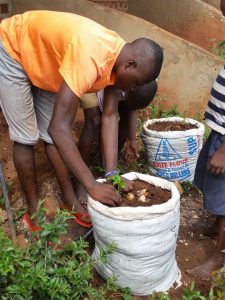 Step one is to understand the background of this system of farming. Many people in Uganda believed it a time wasting venture to cultivate around the home, since not so long ago there was an abundance of available productive land.
Step one is to understand the background of this system of farming. Many people in Uganda believed it a time wasting venture to cultivate around the home, since not so long ago there was an abundance of available productive land.
This trend has however changed with the forces of climate and seasonal changes and also diminishing land resources especially due to population explosions; in that formerly remote places are now densely populated.
Many interventions have come in from local authorities and civil organisations to help with this phenomenon. The current generation seems to have decided to learn and borrow a leaf from our past. This is visible in the various ways in which hunger and food shortages are being overcome. I love home gardening because it is proving to be working very well within the areas I have visited through my job as Permaculture Teacher at S.A.L.V.E..
Starting your home garden
Step two means we have to decide which garden type/s to cultivate since there are so many different types we could choose in order to grow vegetable crops and flowers (according to the nature and size of the garden). A few examples may include kitchen gardens, compost gardens, scented gardens, roof top gardens, flower garden, hanging gardens, keyhole gardens, botanical gardens, ornaments/herbal gardens and many others.
Step three takes us onto producing a clear plan based on the different sites in the home garden and which gardens we chose (for this we use permaculture principles to work with the land as best as we can). This helps in budgeting to find out what is really required and also to determine the type of crops to be grown. This level also calls for mapping and, at the end, one comes up with a clear design or map of the home garden and the rest is just following this design to see its fruition.
Showing an example home garden at S.A.L.V.E.
At the S.A.L.V.E. land, we have decided to implement and always improve these gardens by following the required steps. Along with the children under rehabilitation within our three homes, we have raised beautiful gardens of both leafy and fruit vegetables. The children are also slowly falling in love with home gardening, many having previously had a totally negative attitude to farming because to them it was a punishment and a curse to poor people. Equipped with permaculture knowledge, they now find it fulfilling to see how easy it is to produce useful vegetables, fruits and flowers for food and for beautification of the home.
Children are encouraged to first of all learn and understand the essence of environmental care where we encounter gardening as just a small part of the bigger subject. This is done in a class learning system where lessons are held in this direction. We later hold practical sessions which help them to understand in detail about the different topics.
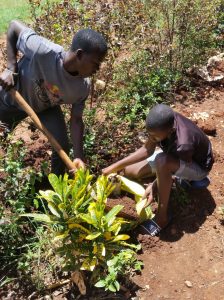 The practical sessions include land preparation; where soil is transformed to better shapes and doing away with foreign materials such as stones and plastics. At this point, we further apply organic manures; from either animal sources (our ever growing herd of goats!) or from plant sources, such as the decomposed kitchen and garden waste. We further carry out soil improvement by use of recyclable organic residues especially from our kitchens that are duly composted to form rich manures. This is mixed with the soil to build up its fertility level causing the planted materials to vividly flourish. Thanks also to our compost bin which is adding to the “magic” by consistently improving on our soil’s fertility and productivity levels.
The practical sessions include land preparation; where soil is transformed to better shapes and doing away with foreign materials such as stones and plastics. At this point, we further apply organic manures; from either animal sources (our ever growing herd of goats!) or from plant sources, such as the decomposed kitchen and garden waste. We further carry out soil improvement by use of recyclable organic residues especially from our kitchens that are duly composted to form rich manures. This is mixed with the soil to build up its fertility level causing the planted materials to vividly flourish. Thanks also to our compost bin which is adding to the “magic” by consistently improving on our soil’s fertility and productivity levels.
A mixture of these is done making the soil ready to receive seeds/seedlings. We also hold lessons on transplanting; teaching children about care for seedlings to see to it that they become viable plants which will bear useful fruits. Care and maintenance of the gardens is carried out up to the level of harvest where we see the intended end of our endeavour.
We then celebrate the victories together with the children when we receive our fruits!
We should all practice home gardening
I highly recommend flower gardening for local farmers especially around the home to help beautify it. Farmers also practice companion planting using some flower species which are usually grown along with vegetable crops. These companion plants, like marigolds, help deter some pests since they act as repellents due to their strong smells.
We need to acknowledge and come to terms with the concern of global warming and climate change by not treating and thinking of it as a hoax but a real problem of our current generation; identifying the linkages through which it directly and indirectly leads to children vacating their homes to destitute places where they possess no realistic future.
I take this opportunity to call on our fellow residents, community leaders, civil society organisations, the government and the entire global community to take this issue of children living away from their homes very seriously.
Home gardening and many other farming interventions can come in handy in lowering the effects of seasonal changes as well as giving these children the chance to learn new skills and change their outlook on farming.
Until next time… See you in the garden!

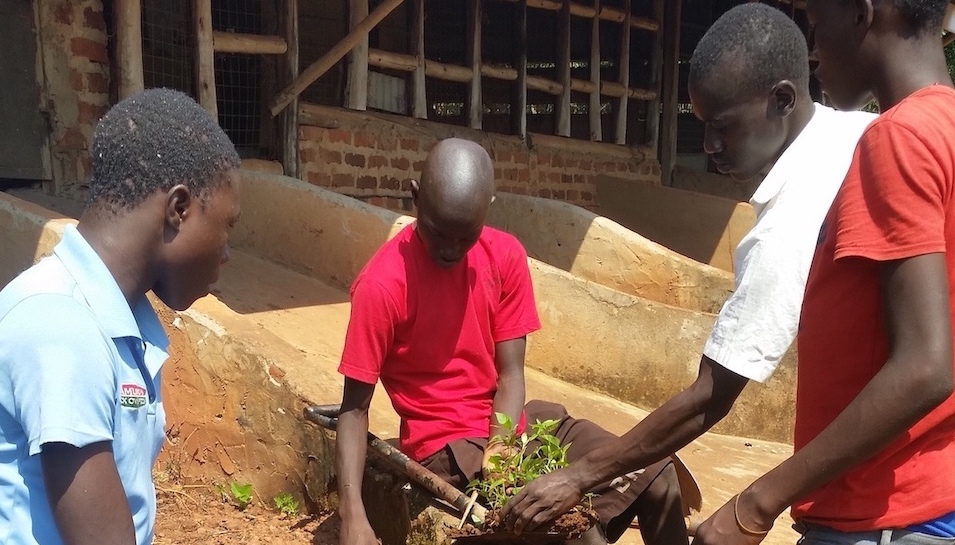
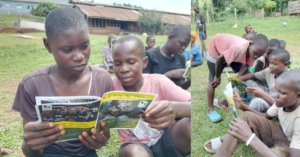
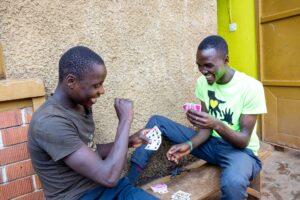

0 Comments